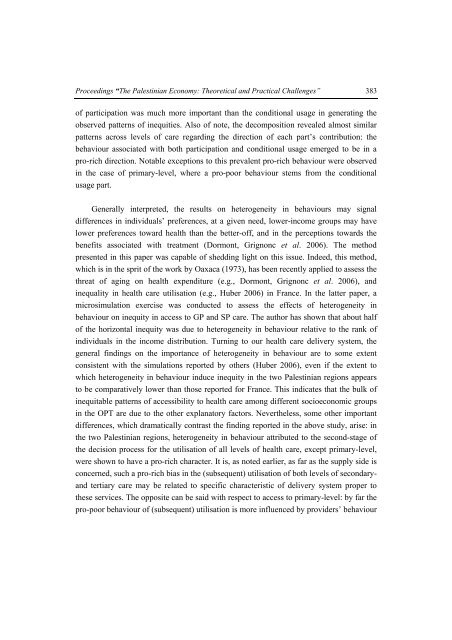The Palestinian Economy. Theoretical and Practical Challenges
The Palestinian Economy. Theoretical and Practical Challenges
The Palestinian Economy. Theoretical and Practical Challenges
Create successful ePaper yourself
Turn your PDF publications into a flip-book with our unique Google optimized e-Paper software.
Proceedings “<strong>The</strong> <strong>Palestinian</strong> <strong>Economy</strong>: <strong>The</strong>oretical <strong>and</strong> <strong>Practical</strong> <strong>Challenges</strong>” 383<br />
of participation was much more important than the conditional usage in generating the<br />
observed patterns of inequities. Also of note, the decomposition revealed almost similar<br />
patterns across levels of care regarding the direction of each part’s contribution: the<br />
behaviour associated with both participation <strong>and</strong> conditional usage emerged to be in a<br />
pro-rich direction. Notable exceptions to this prevalent pro-rich behaviour were observed<br />
in the case of primary-level, where a pro-poor behaviour stems from the conditional<br />
usage part.<br />
Generally interpreted, the results on heterogeneity in behaviours may signal<br />
differences in individuals’ preferences, at a given need, lower-income groups may have<br />
lower preferences toward health than the better-off, <strong>and</strong> in the perceptions towards the<br />
benefits associated with treatment (Dormont, Grignonc et al. 2006). <strong>The</strong> method<br />
presented in this paper was capable of shedding light on this issue. Indeed, this method,<br />
which is in the sprit of the work by Oaxaca (1973), has been recently applied to assess the<br />
threat of aging on health expenditure (e.g., Dormont, Grignonc et al. 2006), <strong>and</strong><br />
inequality in health care utilisation (e.g., Huber 2006) in France. In the latter paper, a<br />
microsimulation exercise was conducted to assess the effects of heterogeneity in<br />
behaviour on inequity in access to GP <strong>and</strong> SP care. <strong>The</strong> author has shown that about half<br />
of the horizontal inequity was due to heterogeneity in behaviour relative to the rank of<br />
individuals in the income distribution. Turning to our health care delivery system, the<br />
general findings on the importance of heterogeneity in behaviour are to some extent<br />
consistent with the simulations reported by others (Huber 2006), even if the extent to<br />
which heterogeneity in behaviour induce inequity in the two <strong>Palestinian</strong> regions appears<br />
to be comparatively lower than those reported for France. This indicates that the bulk of<br />
inequitable patterns of accessibility to health care among different socioeconomic groups<br />
in the OPT are due to the other explanatory factors. Nevertheless, some other important<br />
differences, which dramatically contrast the finding reported in the above study, arise: in<br />
the two <strong>Palestinian</strong> regions, heterogeneity in behaviour attributed to the second-stage of<br />
the decision process for the utilisation of all levels of health care, except primary-level,<br />
were shown to have a pro-rich character. It is, as noted earlier, as far as the supply side is<br />
concerned, such a pro-rich bias in the (subsequent) utilisation of both levels of secondary<strong>and</strong><br />
tertiary care may be related to specific characteristic of delivery system proper to<br />
these services. <strong>The</strong> opposite can be said with respect to access to primary-level: by far the<br />
pro-poor behaviour of (subsequent) utilisation is more influenced by providers’ behaviour
















